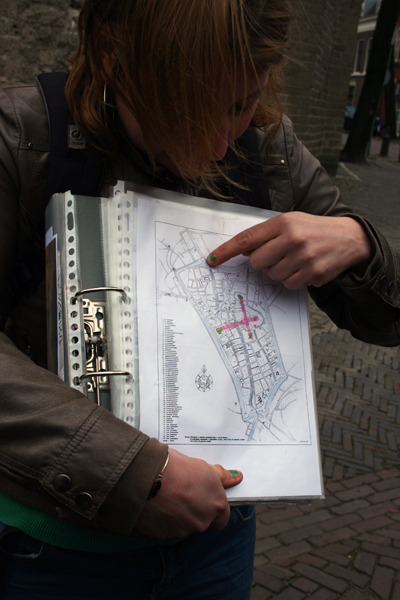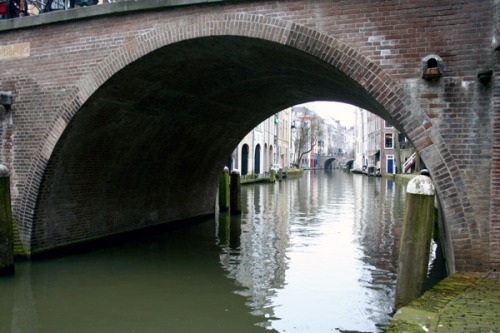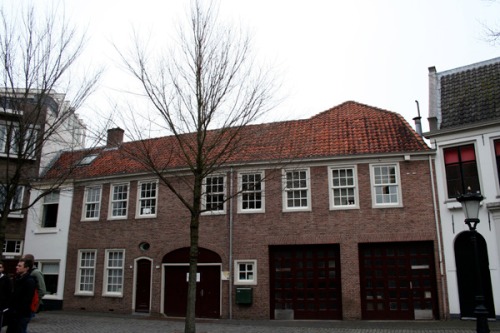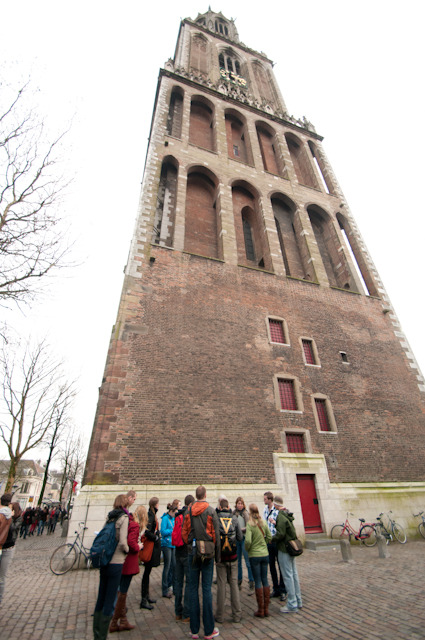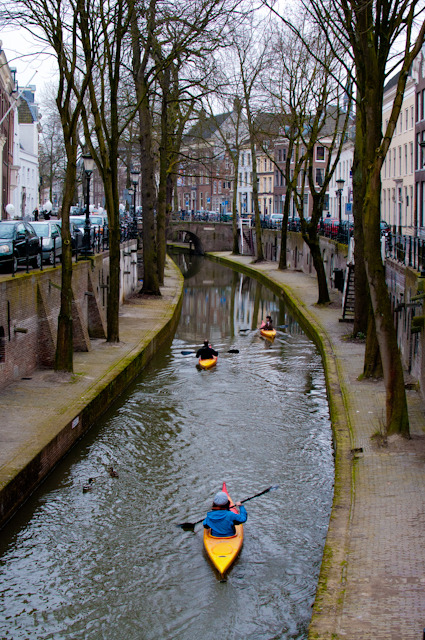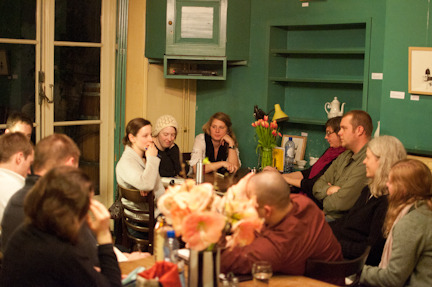Images: Kammeron Hughes
01: Eefje showing our group the cross-like configuration of the churches in the city of Utrecht.
02: Each arch inside the church has a unique design, showcasing the stone-working skills of Utrecht’s artists.
03: The canals of Utrecht are sunken beneath the street level, and often lined by cellar space and street trees.
04: This sunken canal space lends an unique inhabitable space to the urban environment.
05: The importance of water in Utrecht is illustrated by the placement of front building facades pointing towards the canal, and the less exciting rear entrances facing inner plazas and streets.
Images: Brendan Dougherty
01: Start of the tour at St. Martin’s Cathedral’s 112 m (368 ft) high Dom Tower. The tower is the hallmark of the city.
02: Eefje (our tour guide) discuses the history of the cloister at St. Martin’s Cathedral
03: Kayakers explore the Nieuwegracht (new canal)
04: Eefje explaining the public and private realms along the canal.
05: Days debrief back at the hostel
Day 1: March 4, 2012
By: Eric Alward
We made it to Utrecht! It’s great seeing some familiar faces again after traveling for spring break. We all had some good stories to share with one another after coming from all over Europe.
-Eric O, Bill, Mike and I spent time in The Czech Republic and Germany.
-Matt and Liz both came from Amsterdam.
-Brendan came from France and Belgium.
-Andrew spent time in Denmark
-Kammeron visited Belgium
-Casey stayed in Prague and met Jen in Germany
-Laura and Nicole both came straight from Minneapolis.
After suffering through a grueling overnight train from Berlin, my travel mates and I stumbled to meet everyone at the Hostel Strowis. We checked in and were able to shower and rest a little. This will be our home for the next 4 weeks. We met at 3pm with our instructor Cynthia and hit the town. Our tour guide for the afternoon was a local woman named Eefje. She gave us a short tour of the city showing us the major historical landmarks. We learned about the importance of the Arch Bishop in Utrecht and how the Churches played a major role in the development of the city. The 5 major Churches make a crucifix on the city layout.
Since we are here to study stormwater management, we learned about the Old and New Canals throughout the city. How the water level is managed and how the building footprints are laid out according to the water access. The new canals were used for mainly transportation, drinking, laundry and sewer/waste. The old existing canals were used more for business purposes. The water level was once at street level, since then, all of the structures lining the canal have put in cellars to compensate for the change.
In 1122, Utrecht was given the right to build city walls and they did just that. The main reason was for protection. For this reason, the people crammed into the city walls. The tight winding city layout was formed from the overflow of citizens looking for security.
Later in the night we met for a recap of the day. It was interesting to hear everyone’s reaction to the city and being abroad. I am very excited for this experience and feel it will greatly benefit all of us in our fields of interest. Stormwater management is a major part of life whether people realize it or not. We are here to learn from other cultures and their practice techniques. We will then be able to apply this knowledge to our studies back in the states.
Some classmates’ photo blogs:
http://www.flickr.com/photos/eric_alward/
http://socialpaths.wordpress.com/
http://www.flickr.com/photos/70911948@N04/collections/72157629138860840/
http://www.flickr.com/photos/billbrohman/
http://www.flickr.com/photos/kammeron/
http://www.yetanotherphase.blogspot.com/
Tour of Utrecht
Elizabeth Hixson
After a few bumps along the road in getting to the Netherlands, I arrived safely at our Hostel (http://www.strowis.nl/) on March 2. My first impressions of the Netherlands were:
–Nearly everything is orderly, including the trees
–This country is full of history, tight streets, and very cleanly designed spaces
–People here are generous and helpful, and nearly everyone does speak English
–The streets hold a mix of seemingly chaotic things that all somehow work together (i.e. bikes, buses, and pedestrians all in tight spaces without many accidents)
Our class arrived on March 4 and our first item on the agenda was a tour of Utrecht. I had heard of Utrecht before, having majored in history in college (and studied European history in High School). I had also been in the city exploring for two days. But the tour really showed me that I had a lot more to learn and understand about this fascinating place.
The city has a 2,000 year history, which is much longer than any city I’ve ever lived in. Founded in 49 CE, Utrecht was the site of a Roman Castello, a fortified area with an important church (from what I gathered). Until 1600, it was the largest city in the Netherlands, much bigger than Amsterdam. The city had an Archbishop as well, which made it very significant to the Roman Catholic church. We began our tour at the Dom Church and tower, the tallest point in Utrecht and an excellent symbol of the city’s history. The current tower is gothic in style and dates from the 13th century. The nearby plaza (which we were encouraged to re-envision and design!) and church held a cloister garden with an elegant gothic colonnade and beautifully manicured boxwood hedges. From there we continued out into the city streets.
Our tour guide showed us much about how the church and city merchants together shaped the fabric of the city. From the central Dom Church and tower to the four additional churches aligned in the four cardinal directions, the churches and attached monasteries formed feudal areas (like neighborhoods) whose footprints can still be seen in the street layout. The merchants and city government maintained the canals that were the lifeblood (fire protection, sanitation, transportation of goods, amongst other functions) of the city. When the merchants began a Nieuw vacht (New Canal), they were not allowed to run the canal through church property. The bend in the canal is a physical representation of this historic decision. I’m definitely looking forward to learning more about this city and country over the next four weeks!

